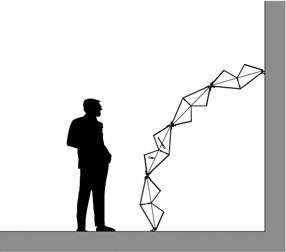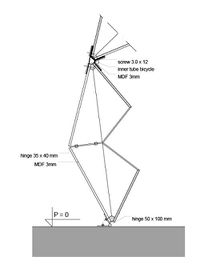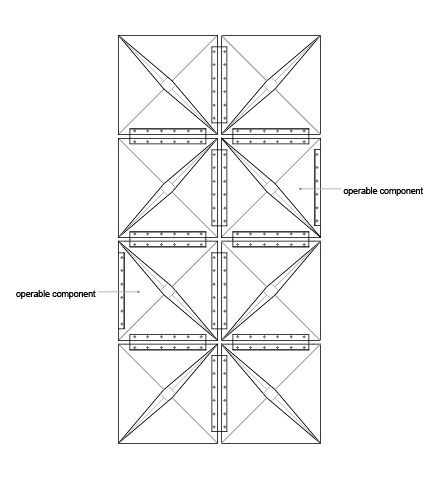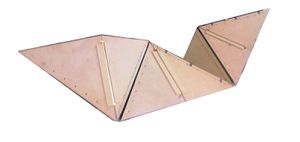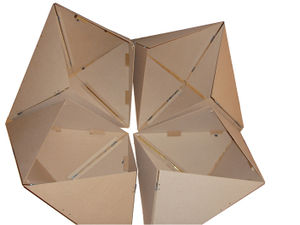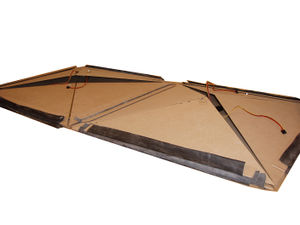project H:Prototype
(→EVALUATION) |
(→EVALUATION) |
||
| Line 94: | Line 94: | ||
As simple as this component is in its geometrical shape, and as easy it is to assemble, it only has one disadvantage. This disadvantage comes in terms of fabrication time. Due to the great number of elements that make up a single component which in turn must be multiplied in order to populate a surface, then, fabrication time becomes very consuming. | As simple as this component is in its geometrical shape, and as easy it is to assemble, it only has one disadvantage. This disadvantage comes in terms of fabrication time. Due to the great number of elements that make up a single component which in turn must be multiplied in order to populate a surface, then, fabrication time becomes very consuming. | ||
| − | Once this pattern was assembled, one of the most important factors learned was the amount of force required to activate it. For instance, when the pattern was laying flat on the ground, it became almost impossible to fold up. Each element along the surface edges required an equal amount of force in order to engage it as a kinetic surface. Therefore, | + | Once this pattern was assembled, one of the most important factors learned was the amount of force required to activate it. For instance, when the pattern was laying flat on the ground, it became almost impossible to fold up. Each element along the surface edges required an equal amount of force in order to engage it as a kinetic surface. Therefore,becoming even more difficult when being handled by only 3 people not being able to exert an even amount of force through out the surface. |
| − | + | ||
| − | becoming even more difficult when being handled by only 3 people not being able to exert an even amount of force through out the surface. | + | |
However, just past the initial kinetic mode, there was a quantifiable decrease in the amount of force required for the surface pattern to keep on contracting. This displacement occurs along the z-axis and x-axis simultaneously. From this exercise, we can conclude that once the surface becomes kinetic, it must never come back to “0” curvature and it must remain at number greater than zero in order to minimize the amount of force required for actuation. | However, just past the initial kinetic mode, there was a quantifiable decrease in the amount of force required for the surface pattern to keep on contracting. This displacement occurs along the z-axis and x-axis simultaneously. From this exercise, we can conclude that once the surface becomes kinetic, it must never come back to “0” curvature and it must remain at number greater than zero in order to minimize the amount of force required for actuation. | ||
In this prototype, we are able to design space and form. What qualifies this prototype as a success lies in that we are able to control shape change at a local level. Another factor that makes this component a success is that we are able to achieve a variety of form and space from single basic geometrical shape (a triangle). | In this prototype, we are able to design space and form. What qualifies this prototype as a success lies in that we are able to control shape change at a local level. Another factor that makes this component a success is that we are able to achieve a variety of form and space from single basic geometrical shape (a triangle). | ||
Revision as of 20:33, 29 January 2012
DESIGN CHALLENGE
DYNAMIC SYSTEMS - responsive, adaptive, kinetic
The objective of this phase was to explore methods and techniques that we have mentioned in the previous phases in respect to the domain and the abstract of the research. As a kinetic exploration, control behaviour is explored. Global control triggers movement as a whole while local control triggers components within a system that can be controlled independently to each other.
RESULT
Our aim was to make an arch but due time and cost we decided to make half an arch. This arch is formed by eight components (four high, two wide) each component has a dimension of 70 X 70 cm. the size varies according to the opening of the component. Only two of the eight components are operable, this is due to the lack of actuators. To create an opening in one component two actuators are required, because the component opens on both sides. The other six components are fixed in an open position. Each component is made out of eight triangles of 3mm thick MDF, eight hinges, two inner tubes of a bicycle and about 72 screws. The total amount spend was around 70 euro’s.
The details first made for the prototype are altered. For external connections, an indigenous approach was formulated. Used rubber tubes from the bikes have been used for this purpose by creating layers for more strength and flexibility between the connections. The hinge from bicycle tires which also forms a connection between the component is changed. Instead of gluing the tires together and bolting it on the triangles. We cut the tires open and fix it with a wooden strip and screws on the triangles (see detail).
No sensors are attached to our prototype. The actuators are connected to arduino and work simultaneously. They can be turn off or on by a switch.
The final shape achieved is a arch like structure. In order to accomplish this shape, its components must be activated in sequence; either from the centre down to is edges or from the edges up to the centre. However, the most efficient way, is to actuate the components starting from the centre down to the edges.
Fabrication time:
4 hrs. (cutting panels)
12 hrs. (hinging elements together)
Total fabrication time: 16 hrs.
(faster assembly process later due to gained experience)
Assembly line:
Actuators:
Depending on their performative need; these are capable to withstand forces under tension, compression, or a combination of both. Through out the fabrication from physical prototype, and the study of their kinetic behaviour, we are able to recognize the forces required in terms of structural integrity. In this case, we are aiming to introduce linear actuators not only for kinematic behaviour, but also as structural components. Therefore, for the purpose of these exercises, we will rely on actuators resisting both tension and compression forces. In turn maintaining continuous equilibrium within the system.
In respect to kinetic behaviour, every component in the system is equipped with two pairs of actuators. One pair running along the x-axis (horizontal displacement) and a second pair running along the y-axis (vertical displacement).
Both acting under tension and compression. Their application pushes the component apart for surface expansion and also pulls the component closer to itself for surface compression.
EVALUATION
As simple as this component is in its geometrical shape, and as easy it is to assemble, it only has one disadvantage. This disadvantage comes in terms of fabrication time. Due to the great number of elements that make up a single component which in turn must be multiplied in order to populate a surface, then, fabrication time becomes very consuming.
Once this pattern was assembled, one of the most important factors learned was the amount of force required to activate it. For instance, when the pattern was laying flat on the ground, it became almost impossible to fold up. Each element along the surface edges required an equal amount of force in order to engage it as a kinetic surface. Therefore,becoming even more difficult when being handled by only 3 people not being able to exert an even amount of force through out the surface.
However, just past the initial kinetic mode, there was a quantifiable decrease in the amount of force required for the surface pattern to keep on contracting. This displacement occurs along the z-axis and x-axis simultaneously. From this exercise, we can conclude that once the surface becomes kinetic, it must never come back to “0” curvature and it must remain at number greater than zero in order to minimize the amount of force required for actuation.
In this prototype, we are able to design space and form. What qualifies this prototype as a success lies in that we are able to control shape change at a local level. Another factor that makes this component a success is that we are able to achieve a variety of form and space from single basic geometrical shape (a triangle).
